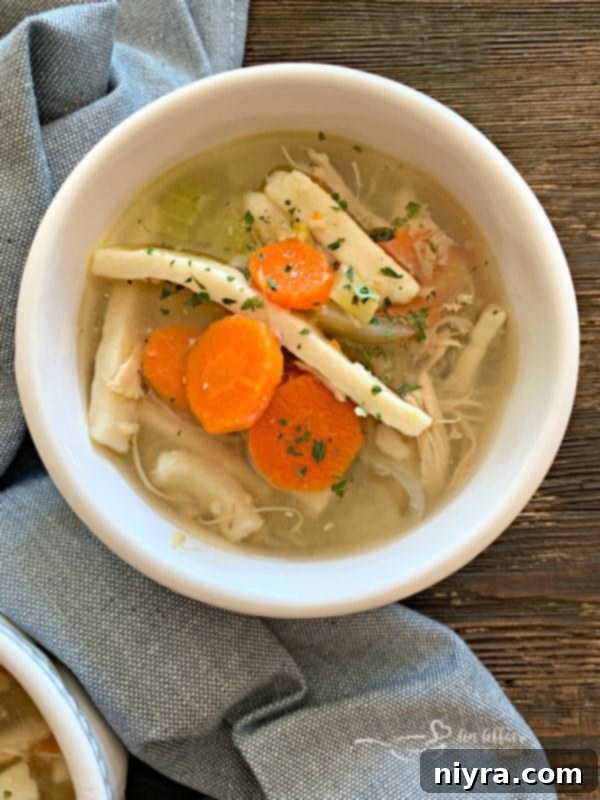Transform your holiday leftovers into a heartwarming and incredibly flavorful Turkey Noodle Soup. This guide shows you how to craft a rich, homemade turkey stock and combine it with tender turkey meat, fresh vegetables, and thick egg noodles for the ultimate comfort food experience. Don’t just repurpose; elevate your leftovers into a culinary masterpiece!
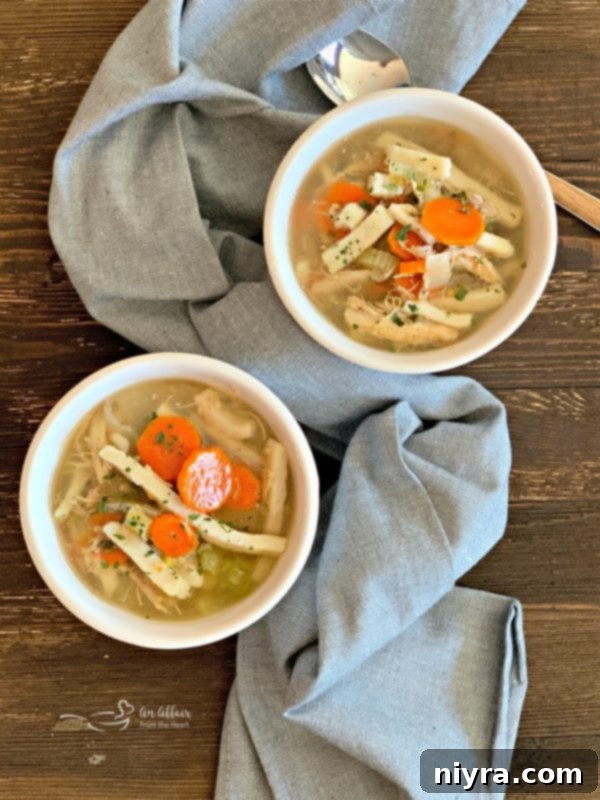
There’s something uniquely comforting about a bowl of homemade turkey noodle soup. It’s more than just a meal; it’s a culinary hug, a warm embrace that transports you back to cherished holiday gatherings and joyous occasions. This isn’t just about satisfying hunger; it’s about extending the warmth and nostalgia of your holiday feast, transforming simple leftovers into a dish rich with flavor and memory.
The Enduring Charm of Homemade Turkey Noodle Soup
After the grandeur of a holiday meal, especially Thanksgiving, the celebration doesn’t have to end. In fact, for many, the true magic begins when the turkey carcass is transformed into a rich, aromatic stock, destined to become the foundation of an unforgettable turkey noodle soup. This tradition is a testament to mindful cooking, ensuring no part of your magnificent turkey goes to waste, and every last drop of flavor is savored.
A truly homemade turkey noodle soup stands miles apart from its canned or boxed counterparts. While convenience has its place, the depth of flavor, controlled sodium levels, generous portions of succulent turkey, perfectly cooked noodles, and crisp-tender vegetables in a scratch-made soup are unparalleled. It’s a difference you can taste and feel—a difference that elevates it from a simple meal to a cherished experience. Turkey noodle soup, in its purest form, deserves nothing less than this homemade excellence.
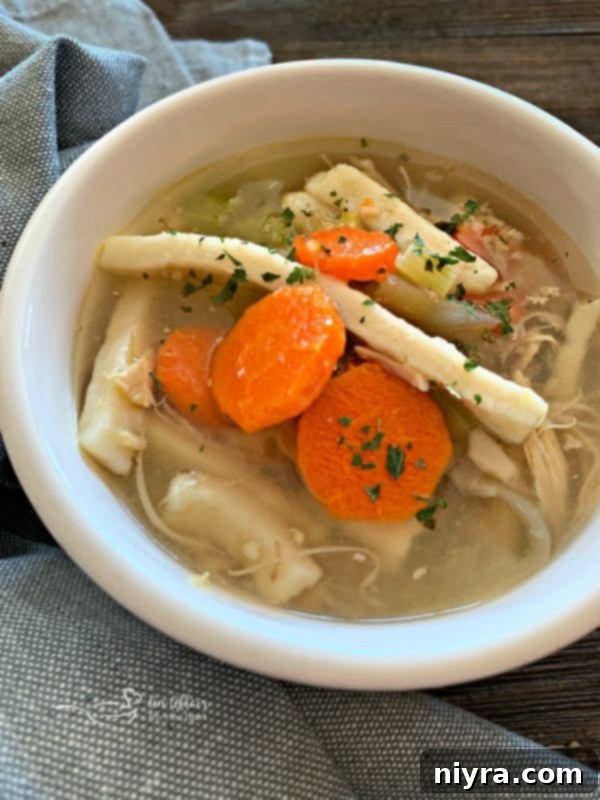
Crafting the Perfect Turkey Stock: The Heart of Your Soup
The secret to an exceptional turkey noodle soup begins and ends with an outstanding homemade turkey stock. This flavorful liquid forms the bedrock upon which all other ingredients build, creating a harmonious and robust taste profile. Making your own turkey stock requires minimal effort, primarily simmering time, but yields immense rewards, not only in flavor but also in the satisfying feeling of utilizing every last bit of your holiday turkey.
How Long to Simmer Your Turkey Stock for Maximum Flavor?
For a truly rich and flavorful turkey stock, you’ll want to simmer it long enough for all the residual meat and flavors to release from the bones. While 45 minutes can yield a basic broth, I often recommend simmering your turkey carcass for at least double that time, typically 1.5 to 2 hours, or even longer. This extended simmer extracts a deeper, more complex flavor profile and ensures the meat virtually falls off the bone, making it easy to pick for your soup.
Some culinary traditions, particularly in Asia, boast restaurants that have kept stockpots simmering for decades, even centuries, constantly adding to and refreshing the broth. While you don’t need to commit to a century-long simmer, the principle holds: longer, slow simmering develops profound depth. If you choose to simmer for several hours, remember to keep the heat low (a gentle simmer, not a rolling boil) and periodically add water to keep the solids fully submerged, compensating for evaporation.
There’s a subtle art to simmering time. For a clearer broth, a shorter, more controlled boil might be preferred, as excessive agitation can cloud the stock. However, if a deep, complex, and intensely savory flavor is your goal, then a slow, extended simmer is your best friend. The longer the bones and aromatics mingle in the simmering water, the more collagen, minerals, and rich flavors are extracted, resulting in a superior base for your turkey noodle soup.
Achieving Noodle Perfection: Texture Matters
One of the hallmarks of an exceptional turkey noodle soup is perfectly cooked noodles. The ideal texture is “al dente,” meaning they retain a slight firmness, a “little bite,” and aren’t mushy or disintegrated. To achieve this, a key technique is to cook your egg noodles separately from the soup and undercook them just slightly.
By cooking the noodles separately and halting the process a minute or two before they reach full doneness, you ensure that when they are added to the hot turkey stock just before serving, they will finish cooking to perfection. This method prevents them from becoming waterlogged and mushy, maintaining their delightful texture even as they absorb the rich flavors of the broth. It’s a small step that makes a significant difference in the overall quality and enjoyment of your turkey noodle soup.
For an even more authentic and superior noodle experience, consider making your own Homemade Egg Noodles. The freshness, chewiness, and flavor of homemade noodles truly elevate this dish to an unparalleled level of comfort. It’s a decision you absolutely won’t regret!
Adding the Right Turkey: Maximizing Flavor from Leftovers
The beauty of making turkey noodle soup from scratch lies in utilizing every part of your holiday bird. The turkey carcass, after being simmered for stock, typically yields a surprising amount of tender, flavorful meat. As the bones cook down, the meat naturally loosens and falls away, making it incredibly easy to pick out and shred for your soup. You’ll often find yourself with more turkey meat than you anticipated!
Beyond the carcass meat, don’t hesitate to incorporate any other leftover turkey carvings you might have. While dark meat often boasts a richer, more pronounced “turkey” flavor, white meat also works wonderfully, adding lean protein and a lighter texture. A mix of both can provide a delightful balance of taste and mouthfeel in your finished soup. Ensure the turkey is shredded or diced into bite-sized pieces for easy eating.
The Art of Fresh Vegetables: Crunch Without Mush
Just as with the noodles, the vegetables in your turkey noodle soup deserve careful attention to achieve the perfect texture. The vegetables (carrots, celery, onions) used to make the initial stock have given their all to the broth; they’re typically mushy and devoid of flavor. These should be discarded (though your furry friends might appreciate them!). For the soup itself, you’ll want to add fresh vegetables.
To avoid mushy veggies in your final bowl, it’s best to parboil the carrots and celery separately until they are just tender-crisp. This means they are cooked through but still have a slight “snap” to them. Add these perfectly cooked vegetables to the soup only when you’re ready to combine all the elements. This technique prevents overcooking and ensures that your carrots and celery retain their vibrant color, distinct flavor, and that delightful crunch—a sweet spot between raw and mushy that truly enhances the soup experience. You can also add other fresh vegetables like peas, corn, or diced potatoes for added variety and nutrition, timing their addition to achieve similar tender-crisp results.
Storing Your Culinary Masterpiece: Enjoying Later
If you’re making a large batch of turkey noodle soup, or simply want to savor the flavors of your homemade stock for future meals, clever storage is key. The absolute best way to store your soup for later enjoyment, particularly if you aim to maintain optimal texture for noodles and vegetables, is to store frozen blocks of your pure, homemade turkey stock.
Why this approach?
You *can* freeze the entire soup—turkey, noodles, vegetables, and all—together. And it will still taste delicious upon thawing and reheating. However, this method often leads to a compromise in texture; the noodles can become soft and mushy, and the vegetables might lose their pleasant bite, resulting in a soup that more closely resembles its canned counterparts. While perfectly edible, it won’t have the fresh, vibrant quality of a freshly assembled bowl.
By freezing just the turkey stock, you preserve its pristine flavor and consistency. When you’re ready for another comforting bowl, simply thaw a block of stock, bring it to a simmer, then add freshly cooked noodles and parboiled vegetables (and any leftover turkey meat) to the hot broth. This ensures every ingredient retains its perfect doneness and texture, allowing you to enjoy a homemade turkey noodle soup that tastes as fresh as the day it was made. For freezing stock, use tall, lidded plastic containers or freezer-safe bags. Remember to leave about an inch of headspace at the top of containers, as liquids expand when frozen, preventing cracks or spills.
^Love this Recipe? Pin it for Later!^
Don’t let this fantastic Turkey Noodle Soup recipe get lost! Pin it to your favorite Pinterest board so you can easily find it whenever you’re craving a hearty, comforting bowl of homemade goodness.
What Can I Serve With Turkey Noodle Soup?
- Homemade Croutons, Made with Leftover Bread: Add a delightful crunch and soak up the flavorful broth.
- Winter Fruit Salad with Lemon Vinaigrette: A light, refreshing counterpoint to the rich soup.
- No-Knead Crusty Dutch Oven Bread: Perfect for dipping and sopping up every last drop.
- Cheesy Cornbread Drop Biscuits: A savory, fluffy side that complements the rustic feel of the soup.
- Loaded Spinach Salad with Creamy Roasted Garlic Dressing: A fresh, vibrant salad for a balanced meal.
- The Very Best Banana Bread: A hint of sweetness to round out your meal.
This homemade turkey noodle soup is wonderfully hearty and satisfying on its own, making it a complete meal. However, if you enjoy pairing your soup with a fresh salad or a delicious slice of bread, the recipes listed above are sure to enhance your dining experience and perfectly complement the comforting flavors of your turkey noodle soup.
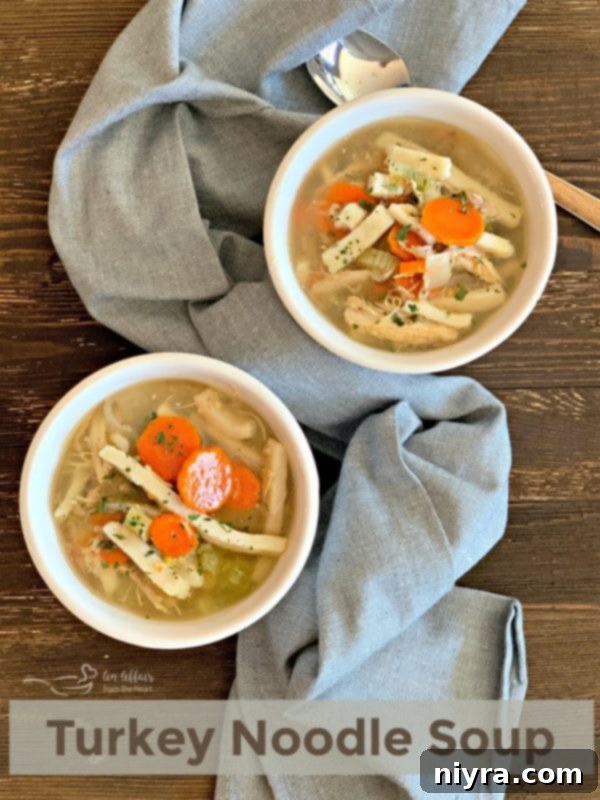
I sincerely hope you find immense joy and comfort in preparing and savoring this incredible Turkey Noodle Soup recipe! It’s a wonderful way to extend the holiday spirit and enjoy truly nourishing, homemade goodness. 
LIKE THIS RECIPE?
Don’t forget to give it a ⭐️⭐️⭐️⭐️⭐️ star rating and
leave a comment below the recipe!
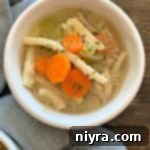
Print Recipe
Homemade Turkey Noodle Soup
Equipment
- Zyliss Comfort Utility Knife
- Lodge 6 Quart Enameled Cast Iron Dutch Oven
Ingredients
- Leftover Cooked Turkey, shredded or diced
- Homemade Turkey Stock or quality chicken stock
- 4 stalks celery, sliced
- 2-3 carrots, peeled and sliced into rounds
- 1 small onion, chopped
- Salt and Pepper, to taste
- 12 ounces Egg Noodles, cooked al dente
Instructions
- Begin by preparing your vegetables: peel and slice the carrots, chop the celery, and dice the onion. Add these fresh vegetables to a large soup pot. Pour in your homemade turkey stock (or a good quality chicken stock) until the vegetables are just covered. Bring to a boil, then reduce heat and simmer until the vegetables reach your desired tenderness—tender-crisp is ideal, not mushy.
- Once the vegetables are cooked, add the shredded or diced leftover turkey meat to the pot. Allow it to heat through gently in the simmering stock.
- While the soup is simmering, cook your egg noodles separately according to package directions, but aim for an “al dente” texture, slightly undercooked. Drain the noodles. Add the prepared noodles directly to the soup pot just before serving. This prevents them from becoming overcooked and mushy.
- Season the soup with salt and pepper to taste, adjusting as needed. Ladle into bowls and serve immediately, enjoying the comforting warmth of your homemade turkey noodle soup.
Notes
Nutrition
Calories: 157kcal |
Carbohydrates: 23g |
Protein: 10g |
Fat: 3g |
Saturated Fat: 1g |
Polyunsaturated Fat: 2g |
Cholesterol: 22mg |
Sodium: 163mg |
Fiber: 2g |
Sugar: 3g

